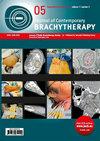带有弯曲针道的 3D 打印阴道圆柱模板,用于 MRI 引导下的阴道袖带近距离治疗
IF 1.1
4区 医学
Q4 ONCOLOGY
引用次数: 0
摘要
材料与方法:本研究选择了两名接受过外照射放疗和核磁共振成像引导的间质近距离放射治疗的阴道袖带肿瘤患者。治疗前,将一个与 3D-PVCT 大小相同的阴道圆柱体插入阴道。进行磁共振扫描以确定靶体积和危险器官(OAR)。通过登记技术确定植入角度,选择合适的针道,并记录每个针位的深度。在实际治疗过程中,患者处于全身麻醉状态,经直肠超声实时引导,参照预先确定的治疗方案。2 号患者的阴道袖带肿瘤中插入了 7 根针,其中 6 条弯曲针道和 1 条直针道。两名患者的靶点体积和OAR的剂量均符合EMBRACE II剂量限制。在分别随访 15 个月和 18 个月后,两名患者均出现完全反应,无肿瘤复发迹象。结论:通过精心的前期规划,3D-PVCT 可以很好地覆盖靶点,并保留 OAR。这两名患者的结果表明,这种方法因其灵活性和未来广泛应用的潜力而大有可为。本文章由计算机程序翻译,如有差异,请以英文原文为准。
3D-printed vaginal cylindrical template with curved needle channels in MRI-guided vaginal cuff brachytherapy
Purpose:
To present a new technique for the treatment of vaginal cuff recurrences using 3D-printed vaginal cylindrical template (3D-PVCT) with curved needle channels in brachytherapy.
Material and methods:
Two patients with vaginal cuff tumor treated with external beam radiotherapy and MRI-guided interstitial brachytherapy were selected for the present study. Prior to treatment, a vaginal cylinder with the same size as 3D-PVCT was inserted into the vagina. Magnetic resonance scan was performed to identify target volumes and organs at risk (OARs). By registration techniques, the implantation angle was determined, appropriate needle channels were selected, and the depth of each needle position was recorded. During the actual treatment, patients were under general anesthesia, and real-time guidance of trans-rectal ultrasound was applied referring to a pre-determined treatment plan.
Results:
For patient No. 1, 9 needles were inserted into the tumor, with 4 curved needle channels and 5 straight channels. For patient No. 2, 7 needles were inserted into the vaginal cuff tumor, with 6 curved needle channels and 1 straight channel. Doses delivered to volumes of targets and OARs for both patients met the EMBRACE II dose constraints. After follow-up of 15 and 18 months, respectively, both patients showed complete response, with no evidence of tumor recurrence. No significant acute or late toxicities were reported.
Conclusions:
With careful pre-planning, 3D-PVCT provides good target coverage and sparing of OARs. The results from these two patients indicate that this approach is very promising due to its flexibility and potential widespread application in the future.
To present a new technique for the treatment of vaginal cuff recurrences using 3D-printed vaginal cylindrical template (3D-PVCT) with curved needle channels in brachytherapy.
Material and methods:
Two patients with vaginal cuff tumor treated with external beam radiotherapy and MRI-guided interstitial brachytherapy were selected for the present study. Prior to treatment, a vaginal cylinder with the same size as 3D-PVCT was inserted into the vagina. Magnetic resonance scan was performed to identify target volumes and organs at risk (OARs). By registration techniques, the implantation angle was determined, appropriate needle channels were selected, and the depth of each needle position was recorded. During the actual treatment, patients were under general anesthesia, and real-time guidance of trans-rectal ultrasound was applied referring to a pre-determined treatment plan.
Results:
For patient No. 1, 9 needles were inserted into the tumor, with 4 curved needle channels and 5 straight channels. For patient No. 2, 7 needles were inserted into the vaginal cuff tumor, with 6 curved needle channels and 1 straight channel. Doses delivered to volumes of targets and OARs for both patients met the EMBRACE II dose constraints. After follow-up of 15 and 18 months, respectively, both patients showed complete response, with no evidence of tumor recurrence. No significant acute or late toxicities were reported.
Conclusions:
With careful pre-planning, 3D-PVCT provides good target coverage and sparing of OARs. The results from these two patients indicate that this approach is very promising due to its flexibility and potential widespread application in the future.
求助全文
通过发布文献求助,成功后即可免费获取论文全文。
去求助
来源期刊

Journal of Contemporary Brachytherapy
ONCOLOGY-RADIOLOGY, NUCLEAR MEDICINE & MEDICAL IMAGING
CiteScore
2.40
自引率
14.30%
发文量
54
审稿时长
16 weeks
期刊介绍:
The “Journal of Contemporary Brachytherapy” is an international and multidisciplinary journal that will publish papers of original research as well as reviews of articles. Main subjects of the journal include: clinical brachytherapy, combined modality treatment, advances in radiobiology, hyperthermia and tumour biology, as well as physical aspects relevant to brachytherapy, particularly in the field of imaging, dosimetry and radiation therapy planning. Original contributions will include experimental studies of combined modality treatment, tumor sensitization and normal tissue protection, molecular radiation biology, and clinical investigations of cancer treatment in brachytherapy. Another field of interest will be the educational part of the journal.
 求助内容:
求助内容: 应助结果提醒方式:
应助结果提醒方式:


